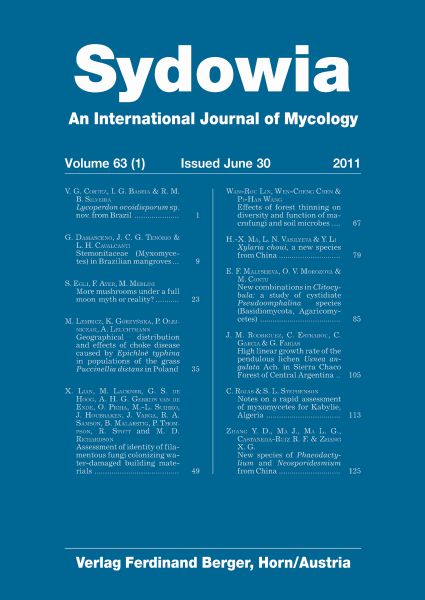
Sydowia Vol. 63/1 E-Book/S 67-77
Effects of forest thinning on diversity and function of macrofungi
Download-Artikel
Artikel Nr 2556
Preis 7,50 €
Lieferstatus 

Buchbeschreibung
Wan-Rou Lin*, Wen-Cheng Chen* & Pi-Han Wang**Department of Life Science, Tunghai University, No. 181, Section 3, Taichung-Harbor Road, Taichung 40704, Taiwan
Lin W. R., Chen W. C. & Wang P. H. (2011) Effects of forest thinning on diversity and func-tion of macrofungi and soil microbes. – Sydowia 63 (1): 67–77.
Forest management activities influence forest structure and development, and thereby influence biodiversity. We investigated diversity and function of macrofungi and soil microbes in a Chamaecyparis formosensis forest with light and heavy thinning treatments and control plots, and we com-pared them with an adjacent broadleaf forest. Principal component analysis was used to separate macrofungal species components exposed to thinning treatments and those in the broadleaf forest. The macrofungal diversity in the broadleaf forest was higher than in the plantations, and the diver-sity of fungi from the lightly thinned plantation was higher than those from the heavily thinned and unthinned plantations. Denaturing gradient gel electrophoresis profiles showed that soil fungal and bacterial communities were significantly different among the treatments. However, the carbon uti-lisation patterns of soil microbes did not differ significantly among treatments. Thinning increased the diversity of saprotrophic macrofungi and changed the soil microbial community of the plantati-on. This finding might be due to the functional redundancy of soil microbes, as there was no signi-ficant thinning effect on the soil microbial function through the fourth year after thinning.
Keywords: fungal diversity, forest thinning, Chamaecyparis formosensis, Taiwan




